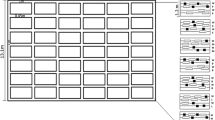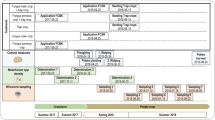Abstract
Wireworms cause considerable damage to a wide range of crops, including maize which is susceptible to attack from emergence to the 10 to 12 leaf stages. One control strategy involves limiting the exposure of young maize were performed with granulated cereal-based baits. Then, this work was subsequently pursued and intensified with experiments based on the use of trap plants. These experimental works provided a description of the implementation conditions, e.g. choice of trap plant species, density, and positioning relative to maize seedlings—in which these trap plants can be used for the protection of maize crops against wireworm attacks. The technique that gave the more promising results in our experiments was based on the use of a mixture of wheat and maize as bait plants. Thus, the protection of maize against wireworm attacks has an efficacy of 55 to 60%, close to the level of protection of the chemical products currently available in Europe. This easy-to-use and effective strategy could help farmers reduce the use of insecticides in the future. Our work also allows us to identify the current benefits and weaknesses of this strategy and to propose research directions to optimise its effectiveness and facilitate its implementation by farmers.







Similar content being viewed by others
Data availability
Data are available.
References
Adhikari A, Reddy GV (2017) Evaluation of trap crops for the management of wireworms in spring wheat in Montana. Arthropod–Plant Interact 11(6):755–766
Barsics F, Haubruge É, Francis F, Verheggen F (2014) The role of olfaction in wireworms: a review on foraging behavior and sensory apparatus. Biotechnol Agron Soc Environ 18(4)
Chaton PF, Lempérière G, Tissut M, Ravanel P (2007) Biological traits and feeding capacity of Agriotes larvae (Coleoptera: Elateridae): a trial of seed coating to control larval populations with the insecticide fipronil. Pestic Biochem Physiol 90(2):97–105
Cooper J, Cherry R, Daroub S (2019) Attraction of the corn wireworm, Melanotus communis (Coleoptera: Elateridae), to carbon dioxide. J Agric Urban Entomol 35(1):30–35
Doane JF, Lee YW, Klingler J, Westcott ND (1975) The orientation response of Ctemcera destructor and other wireworms (Coleoptera: Elateridae) to germinating grain and to carbon dioxide. Can Entomol 107(12):1233–1252
Higginbotham RW, Froese PS, Carter AH (2014) Tolerance of wheat (Poales: Poaceae) seedlings to wireworm (Coleoptera: Elateridae). J Econ Entomol 107(2):833–837
Kirfman GW, Keaster AJ, Story RN (1986) An improved wireworm (Coleoptera: Elateridae) sampling technique for Midwest cornfields. J Kansas Entomol Soc 59(1):37–41
La Forgia D, Thibord JB, Larroudé P, Francis F, Lognay G, Verheggen F (2020) Linking variety-dependent root volatile organic compounds in maize with differential infestation by wireworms. J Pest Sci 93:605–614
La Forgia D, Bruno P, Campos-Herrera R, Turlings TC, Verheggen F (2021) The lure of hidden death: development of an attract-and-kill strategy against Agriotes obscurus (Coleoptera: Elateridae) combining semiochemicals and entomopathogenic nematodes. Turk J Zool. https://doi.org/10.3906/zoo-2106-38
Landl M, Glauninger J (2013) Preliminary investigations into the use of trap crops to control Agriotes spp. (Coleoptera: Elateridae) in potato crops. J Pest Sci 86:85–90
Sharma A, Sandhi RK, Briar SS, Miller JH, Reddy GV (2019) Assessing the performance of pea and lentil at different seeding densities as trap crops for the management of wireworms in spring wheat. J Appl Entomol 143(4):460–469
Sharma A, Jaronski S, Reddy GV (2020) Impact of granular carriers to improve the efficacy of entomopathogenic fungi against wireworms in spring wheat. J Pest Sci 93(1):275–290
Staudacher K, Schallhart N, Thalinger B, Wallinger C, Juen A, Traugott M (2013) Plant diversity affects behavior of generalist root herbivores, reduces crop damage, and enhances crop yield. Ecol Appl 23(5):1135–1145
Thibord J-B (2017) Evaluation de la nuisibilité des ravageurs du maïs en France – CIRAA, Conférence Internationale sur les Ravageurs et Auxiliaires en Agriculture, Montpellier, France, 22–24 octobre 2017. Asso. Fr. de Protection des Plantes (AFPP). https://www.vegephyl.fr/wp-content/uploads/2021/10/CIRAA2017_01_06_THIBORD_JEAN_BAPTISTE.pdf/ (accessed online on December 4, 2022)
Traugott M, Benefer CM, Blackshaw RP, van Herk WG, Vernon RS (2015) Biology, ecology, and control of elaterid beetles in agricultural land. Annu Rev Entomol 60:313–334
Vernon RS (2005) Aggregation and mortality of Agriotes obscurus (Coleoptera: Elateridae) at insecticide-treated trap crops of wheat. J Econ Entomol 98(6):1999–2005
Vernon RS, Kabaluk T, Behringer A (2000) Movement of Agriotes obscurus (Coleoptera: Elateridae) in strawberry (Rosaceae) plantings with wheat (Gramineae) as a trap crop. Can Entomol 132(2):231–241
Vernon RS, van Herk WG, Clodius M, Tolman J (2015) Companion planting attract-and-kill method for wireworm management in potatoes. J Pest Sci 89(2):375–389
Acknowledgements
This work was performed with financial support from the Compte d’Affectation Spécial pour le Développement Agricole et Rural (CASDAR; the Dedicated Account for Agricultural and Rural Development) of the French Ministry of Agriculture and Food and the French Biodiversity Agency, through support for the STARTAUP Project (The ECOPHYTO II Project managed by INRAE) and from SEMAE, through support for the TAUPINLAND Project. We thank the suppliers for providing the bait granules without active ingredient and the experimenters who believed in the baiting strategy and performed the many experiments described here, making it possible to glimpse possibilities for a new strategy for protecting maize against wireworms.
Author information
Authors and Affiliations
Corresponding author
Ethics declarations
Conflict of interest
The authors declare that they have no known competing financial interests or personal relationships that could have appeared to influence the work reported in this paper.
Additional information
Handling Editor: Todd Kabaluk.
Publisher's Note
Springer Nature remains neutral with regard to jurisdictional claims in published maps and institutional affiliations.
Rights and permissions
Springer Nature or its licensor (e.g. a society or other partner) holds exclusive rights to this article under a publishing agreement with the author(s) or other rightsholder(s); author self-archiving of the accepted manuscript version of this article is solely governed by the terms of such publishing agreement and applicable law.
About this article
Cite this article
Thibord, JB., Larroude, P. Baiting to protect maize against wireworms. Arthropod-Plant Interactions 17, 507–515 (2023). https://doi.org/10.1007/s11829-023-09971-y
Received:
Accepted:
Published:
Issue Date:
DOI: https://doi.org/10.1007/s11829-023-09971-y




